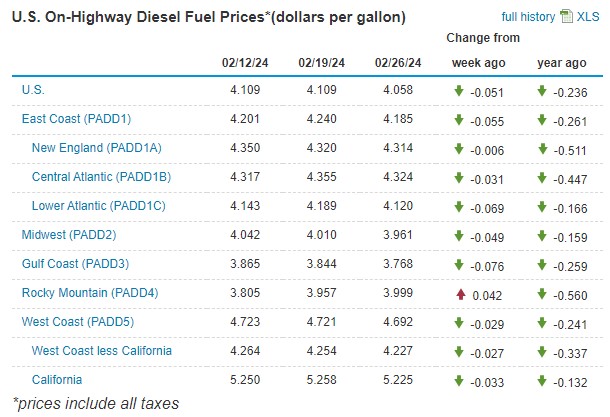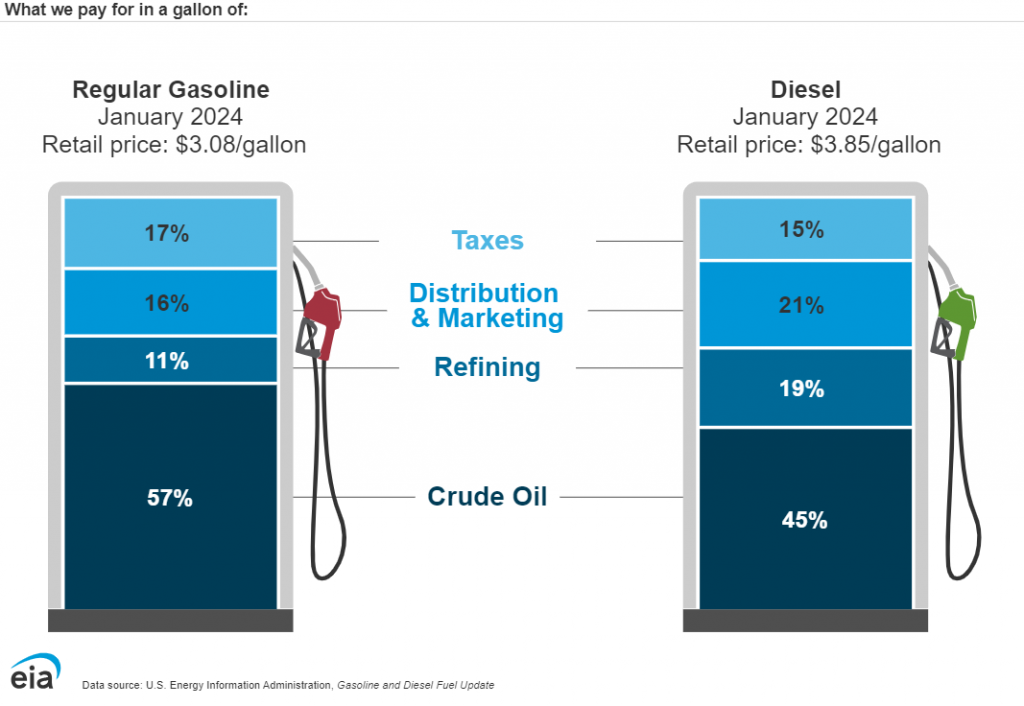Diesel is trucking’s liquid gold. The industry relies on the fuel source to power its fleets and meet the transportation demands of shipper-customers. Unsurprisingly, diesel fuel is one of the largest expenditures for trucking companies and operators. While most Americans may agonize over higher gas prices for their passenger vehicles, trucking’s stakeholders understand higher diesel prices can influence operating costs and, in return, raise freight rates.
National diesel price average drops five cents week-over-week
Data reported by the U.S. Energy Information Administration revealed a nationwide trend in diesel fuel pump prices over the last week of February. In all U.S. regions except one, diesel prices were five cents cheaper on Monday from where they were the previous week.
This week (week of Feb. 26), national diesel fuel pump prices are averaging $4.058 per gallon, according to the EIA. This mark is 23 cents less than the national average this time last year.

While mostly reporting decreases across the board, EIA’s data does reveal one particular outlier. Going against the grain, the Rocky Mountain Region saw diesel prices increase four cents to $3.999 per gallon. While the region’s average is well below the national mark, the relative increase in fuel costs sticks out like a sore thumb. The Rocky Mountain Region consists of five states: Colorado; Idaho; Montana; Utah; and Wyoming.
On the other hand, the Gulf Coast Region saw the most significant decrease. Diesel prices dipped seven cents, lowering the region’s average to $3.768 per gallon. The Gulf Coast Region includes the states of Alabama, Arkansas, Louisiana, Mississippi, New Mexico, and Texas.
The Lower Atlantic, defined by the EIA as a sub-region of the greater U.S. East Coast, trailed behind the Gulf with a considerable drop of 6 cents to per-gallon prices. Diesel is now sitting at $4.120 per gallon. This sub-region covers the states of Florida, Georgia, North Carolina, South Carolina, Virginia, and West Virginia.
Overall, for the week of Feb. 26, the Gulf Coast remains the cheapest region for diesel fuel, while California, which receives its own regional category, retains the honor of being the country’s most expensive at $5.225 per gallon, remarkably higher than the national average.
California is a bustling hub for trucking business, particularly drayage to and from the state’s large seaports of Oakland, Los Angeles, and Long Beach. While the industry accepts California will always possess intimidating fuel costs, the data still surely raises the eyebrows of trucking’s stakeholders.
In comparison to the EIA, motor club AAA reported the national average diesel price as $4.070 per gallon as of yesterday, Feb. 28. This figure is around a cent more expensive than the EIA’s finding, which was released on Monday, Feb. 26.
What goes into the diesel price at the pump?

According to the EIA’s infographic, diesel fuel’s cost can be divvied up into four contributing factors—each one with a varying degree of influence over the final price.
For January 2024, crude oil production was responsible for 45 percent of the average monthly price ($3.85 per gallon). Distribution and marketing followed as the second-largest contributor at 21 percent, while refining costs came in third at 19 percent. Lastly, inevitable government taxes cleaned up at fourth, taking a 15 percent stake in per-gallon transactions.
Final Thoughts
With a seasonal change on the horizon, warmer temperatures and longer days in the spring months typically lead to a rise in fuel prices. However, it’s never as straightforward as that. A myriad of supply chain factors could impact diesel in the coming months, whether they’ll lower costs or raise them.
Contact one of our team members if you have any questions regarding this topic or any others in domestic logistics.
More blogs similar to this:



Recent Comments